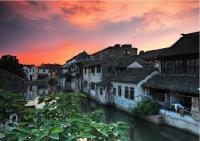Zhangjiajie Facts
Zhangjiajie is situated in the northwest of Hunan province, in the juncture of the Yunan-Guizhou Plateau and the subsidence of Dongting Lake, stretching over the area from between 109`40 to 110`20 E to between 28`52 to 29`48 N. It is bounded by Shimen county and Taoyuan County on the east, Yuanling County on the south, and Hefeng, Xuan'en of Hubei procince on the north. The city stretches 167 km from east to west, and 96 km from north to south at west. Zhangjiajie City covers an area of 9,653 sq. km, which accounts for 4.5 percent of Hunan Province.
Zhangjiajie in Chinese Characters: 张家界
Zhangjiajie in Pinyin: Zhāngjiājiè
Literally Meaning in English: Zhang family's boundary
Previous names: Dayong
Features
1) The Wulingyuan Scenic Area is a large and spectacular natural park.
2) It is a UNESCO World Heritage listed natural wonder.
3) Wulingyuan and Zhangjiajie Village Tours
4) Limestone caves, sandstone formations, natural splendor and hiking
5) About 70% of the population are ethnic minority people.
Main Attractions
1) Wulingyuan Scenic Area, Yellow Dragon Cave, Dragon Emperor Cave, Suoxiyu Nature Reserve, Tianzi Mountain Nature Reserve
2) Most popular souvenirs and local products: ethnic souvenirs, Chinese gooseberry fruit, chestnuts, hazelnuts, local green teas (Qingyan, Mingcui, Maofeng), Chinese painting and calligraphy,
3) Most popular local food: ethnic food such as Sanxiaguo (Tujia hotpot) and local fruits and nuts
History Evolution
The quartzite rock towers and bluffs have inspired generations of painters. One of the rock pillars is an amazing 3,544 feet tall. The Zhangjiajie National Forest Park was the country's first national forest park.
• 1369 Dayong was founded in the Ming Empire.
• 1982 The Zhangjiajie National Forest Park became the first forest park in the country.
• 1992 Wulingyuan was officially recognized as a UNESCO World Heritage Site.
• 1994 The city's name was changed from Dayong to Zhangjiajie.
• 2004 Zhangjiajie Geopark was listed as a UNESCO Global Geopark.
Geography
• Significance of the city: The municipal area of the city includes scenic wonders, caves, and large natural parks. In 2010, 24 million tourists visited the municipal area. The city is also a coal mining, industrial, and agricultural city.
• Nearby cities: H (1 km/1 mi), N (1 km/ mi), S (1 km/7 mi), N (2 km/1 mi)
• Municipality terrain: The main urban area is in a long and narrow east-west running river valley surrounded by mountains.
• Elevation: 183 m (600 ft)
• Main rivers: Lishui River, Mengdong River
Location Information
• Municipality location: central southern China
• Municipality population: 1,700,000
• Municipality area: 9,807 sq km (3,786 sq mi)
• Municipality population density: 173/sq km (500/sq mi)
• North to south distance of main urban area: 4.2 km (2.6 mi)
• East to west distance of main urban area: 11.8 km (7.3 mi) City Center: People's Square (29.12N, 110.48E)
Climate
• Annual average low temperature in January: 1.5 °C (34.7 °F)
• Annual average high temperature in July: 32.6 °C (90.7 °F)
• Humid subtropical climate; annual precipitation: 1,400 mm (55 in)
The area has a humid subtropical climate that varies depending on elevation. There are four distinct seasons.
Economy
• Average annual income: 14,263 RMB (2,008 USD)
• Development: developing, the small city has been designated as a tourist resort city, and it is rapidly developing. There are coal mines, and industrial output is said to have grown 23% in 2010.
• Industry: 62.3% tertiary industry (tourist industry, services), 24.8% secondary (heavy and light industry), 12.9% primary (coal,agriculture)
• CBD: 29.13N,110.48E
• Shopping streets: Renmin Square Commercial Walking Street, Tianzi Commercial Street
Transportation
• Zhangjiajie Hehua Airport is a domestic airport about 4 km (2.5 miles) from the city's center.
• The Zhangjiajie Railway Station is the main station and is 12 km (7 miles) from the city's center.












